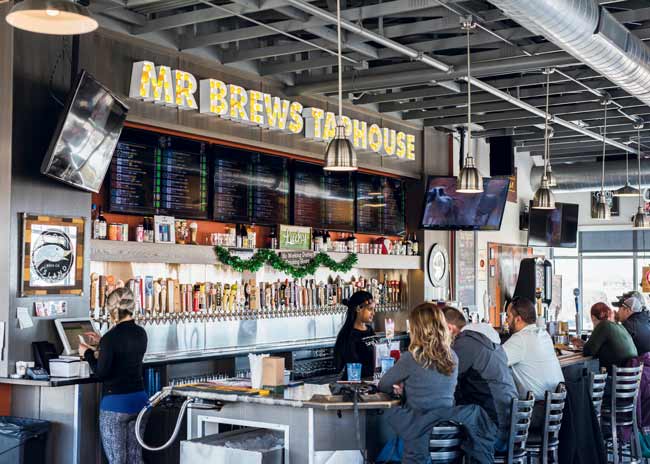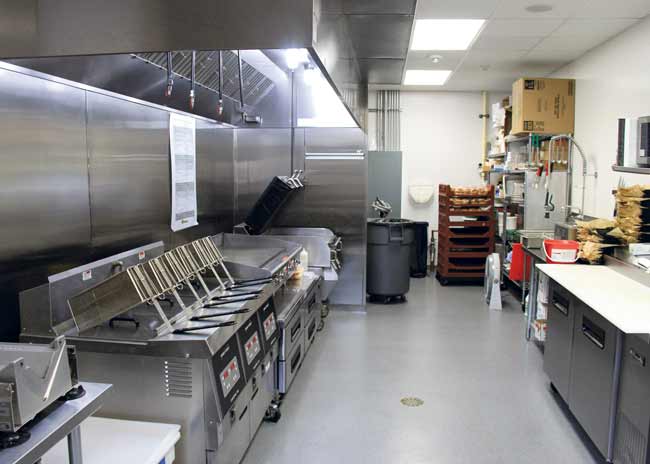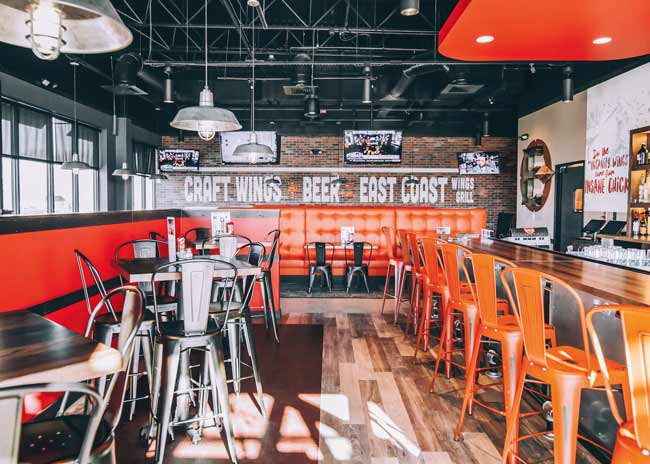“Do more with less” is becoming a common mantra for operators in this segment, as is leveraging technology wherever possible.
 Mr Brews Taphouse, a craft beer and gourmet burger chain based in Wisconsin, operates within a footprint of 3,000 to 3,500 square feet. Image courtesy of Mr Brews TaphouseCasual dining represents a somewhat wide range of restaurants, including national and regional chains as well as franchise-heavy operators and independents. What they all have in common is providing guests a full-service dining experience with limited carryout and delivery, particularly when compared with their fast-casual or quick-serve counterparts. Casual-dining restaurants tend to focus a little more on families and lower price points than fine-dining restaurants.
Mr Brews Taphouse, a craft beer and gourmet burger chain based in Wisconsin, operates within a footprint of 3,000 to 3,500 square feet. Image courtesy of Mr Brews TaphouseCasual dining represents a somewhat wide range of restaurants, including national and regional chains as well as franchise-heavy operators and independents. What they all have in common is providing guests a full-service dining experience with limited carryout and delivery, particularly when compared with their fast-casual or quick-serve counterparts. Casual-dining restaurants tend to focus a little more on families and lower price points than fine-dining restaurants.
On-site dining closures during the height of the pandemic and those that lingered even into 2021 pushed many casual-dining operators to shift to takeout as much as possible but without the infrastructure, delivery options, drive-thru lanes and other well-established off-premises solutions. As such, casual-dining restaurants were forced to do what they could to continue to bring in sales to stay afloat but with less traditional infrastructure used to support off-premises sales.
The casual-dining segment grew 13.8% in 2021, according to research firm Datassential, as consumers were eager to return to the restaurant experience. Casual dining grew another 6% in 2022, per Datassential, but the Chicago-based firm projects a 1.2% decline in sales for 2023. Datassential attributes this potential decline to high inflation rates and talk of a looming recession.
For operators across the board, margins are even slimmer now, with mid-scale and casual-dining restaurants both reporting as low as 13% profit margins today compared with about 20% pre-COVID, per Datassential. In addition to rising food and inflation-related higher costs, all restaurants also have to do more with less labor. All this sounds pretty grim on paper, but on a more positive note, operators keep taking some unprecedented steps to curb costs, enhance efficiencies, and do more with less space and people overall.
The Shrinking Footprint
Enhanced off-premises business complements the smaller footprints that exist in the restaurant space today. That’s the case for East Coast Wings + Grill. “Pre-pandemic, we were already starting to shrink our footprint because we saw rent costs going up at that time,” says the company’s chief development officer Mark Lyso, a 30-year veteran of the restaurant industry.
Lyso points out the average size of the chain’s locations has shrunk from roughly 5,000 square feet to now averaging 3,000 square feet or even less. That has led to designing kitchens that are less spread out than before. “From a design perspective regarding the kitchen and front of the house, we have to think how we can pay one person a higher wage but get more productivity out of that person rather than hire two people and pay them less,” he says.
 Mr Brews Taphouse, a casual dining chain, focuses on gourmet burgers and craft beers in a family-friendly environment. In the kitchen space, the chain relies on double-sided clamshell griddles for consistent, automated cooking of its burgers.Multiuse and highly efficient equipment also help operators do more in less space. Mr Brews Taphouse, a craft beer and gourmet burger chain based in Wisconsin, has always operated within a relatively smaller footprint at 3,000 to 3,500 square feet, says Kenny Leetch, senior vice president of operations for the chain, which includes two company-owned and 12 franchised locations primarily throughout Wisconsin as well as in Arizona and Florida. “Our dual-plate clamshell grills allow us to cook burgers evenly and consistently in just two minutes without the need for heavy training,” he says.
Mr Brews Taphouse, a casual dining chain, focuses on gourmet burgers and craft beers in a family-friendly environment. In the kitchen space, the chain relies on double-sided clamshell griddles for consistent, automated cooking of its burgers.Multiuse and highly efficient equipment also help operators do more in less space. Mr Brews Taphouse, a craft beer and gourmet burger chain based in Wisconsin, has always operated within a relatively smaller footprint at 3,000 to 3,500 square feet, says Kenny Leetch, senior vice president of operations for the chain, which includes two company-owned and 12 franchised locations primarily throughout Wisconsin as well as in Arizona and Florida. “Our dual-plate clamshell grills allow us to cook burgers evenly and consistently in just two minutes without the need for heavy training,” he says.
Datassential’s “2023 Industry Forecast” suggests that whether restaurants sink or swim will depend in large part on whether they embrace technology. “Technology is going to be one of the things that helps differentiate the ‘winners’ from the ‘losers’ if consumers start to pull back their spending in 2023,” according to the report.
Indeed, 57% of operators surveyed by Datassential said they will select equipment and technology that saves on labor. And 46% of operators will make selections based on the versatility of the products.
“Almost every brand we work with has leveraged technology in some way to pull back on costs and requirements for labor, whether it’s as simple as a QR code for ordering, implementing new staffing and management software, or using smarter equipment that knows how long to cook foods and that doesn’t require as much skilled labor at the back of the house,” says Robin Gagnon, co-founder of We Sell Restaurants, a restaurant broker franchise operating in 45 states.
For East Coast Wings, smarter flattop grills are still able to handle the brand’s volume while offering the versatility to cook other menu items like burgers, quesadillas and wraps. The chain has also implemented more automated fryers and moved the dump and saucing station closer to the fryer station to improve the speed of service of its core offering, wings. Upright two-door refrigerators have replaced larger walk-ins and are set close to the line for faster replenishment. Lyso says the team has also implemented some undercounter dish machines to keep things moving on the line.
Leetch says Mr Brews Taphouse has invested in some operational technology as well, including a new fryer oil management system that filters, replaces and replenishes oil without the need for much staff involvement. “It’s a safety thing for us too,” he says.
Casual-dining brands are doing what they can to enhance efficiencies at the operational level, including simply cutting hours of operation. Pre-pandemic, “we saw a situation where more hours were added to dayparts whether or not they were profitable with enough traffic coming through the door,” Gagnon says. “The current staffing crisis has forced operators to really evaluate when and if they need to be open during certain times.”
Maintaining high-level service with less staff remains the million-dollar solution for casual-dining brands. Leetch says his team’s been testing tableside ordering technologies using QR codes with enhanced POS/ticketing software. Mr Brews Taphouse has also partnered with a technology company that handles the application, interview and onboarding processes for new hires, taking the burden off already busy managers. “We’ve already had a lot of success with the program,” Leetch says.
 East Coast Wings + Grill went through several operational and design changes in the past few years, including reducing its footprint, leveraging new technology and rearranging equipment in the kitchen to enhance efficiencies.
East Coast Wings + Grill went through several operational and design changes in the past few years, including reducing its footprint, leveraging new technology and rearranging equipment in the kitchen to enhance efficiencies.
Maintaining Off-Premises
“Casual-dining occasions will still happen, but they may be more focused on special events than everyday meals,” Datassential’s “2023 Industry Forecast” states. For casual-
dining operators, “as consumers cut back on their dining-out occasions, they will prioritize all types of experiences, and mid-scale can find a niche as a more affordable but still full-service experience where consumers can order menu items they can’t easily make at home.”
Still, off-premises remains the ticket to a steady alternative revenue stream for casual-dining brands. In the case of East Coast Wings, “we still have some restaurants bringing in over $2 million in sales, and a lot of that is thanks to our side-door revenue,” Lyso adds. To accommodate this alternative revenue stream, the team brought the to-go packaging station closer to the wings dump station. “Both revenue centers — side-door and dine-in — flow through the same ticketing system, and we’ve designed part of the bar area as a pickup area for carryout so we’re not staging bags by the host desk.” What’s more, all takeout orders are prepaid online.
Restaurants of all types trimmed their menus during the height of the pandemic and remain diligent when it comes to cross-utilization of ingredients and cutting costs. Count East Coast Wings and Mr Brews Taphouse as two of those operators that tightened the menu. “We definitely shrunk our menu some, and this has led to a shortened hood but also led to using different equipment,” Lyso says, referring to the aforementioned flattop griddle.
Mr Brews Taphouse scaled back on certain menu items like fried cauliflower because the ingredients simply were not available for a while. Leetch says that on a positive note, the chain’s gotten more creative of late. For example, its newest, company-owned flagship location, under construction in Northern Wisconsin, will feature a slightly larger back of the house and a 20-foot hood as opposed to a 16-foot hood, “affording us a little more diversity in the menu with a few more options,” he says. “We’re slowly finding our way back toward innovation but not making anything too complicated. We still have to make sure our P&L is protected.”



